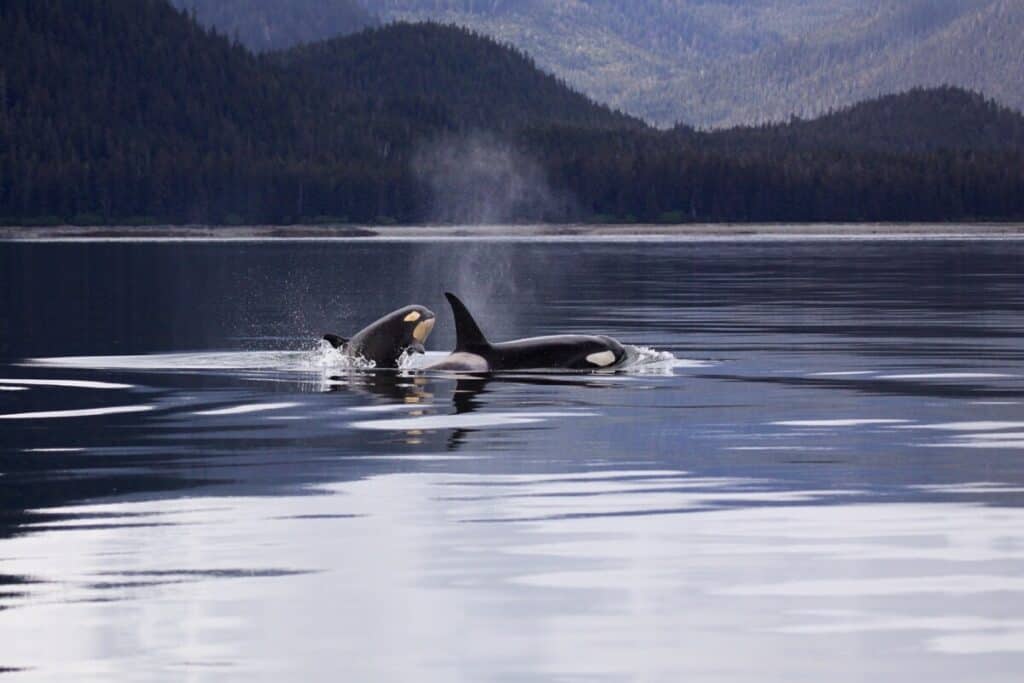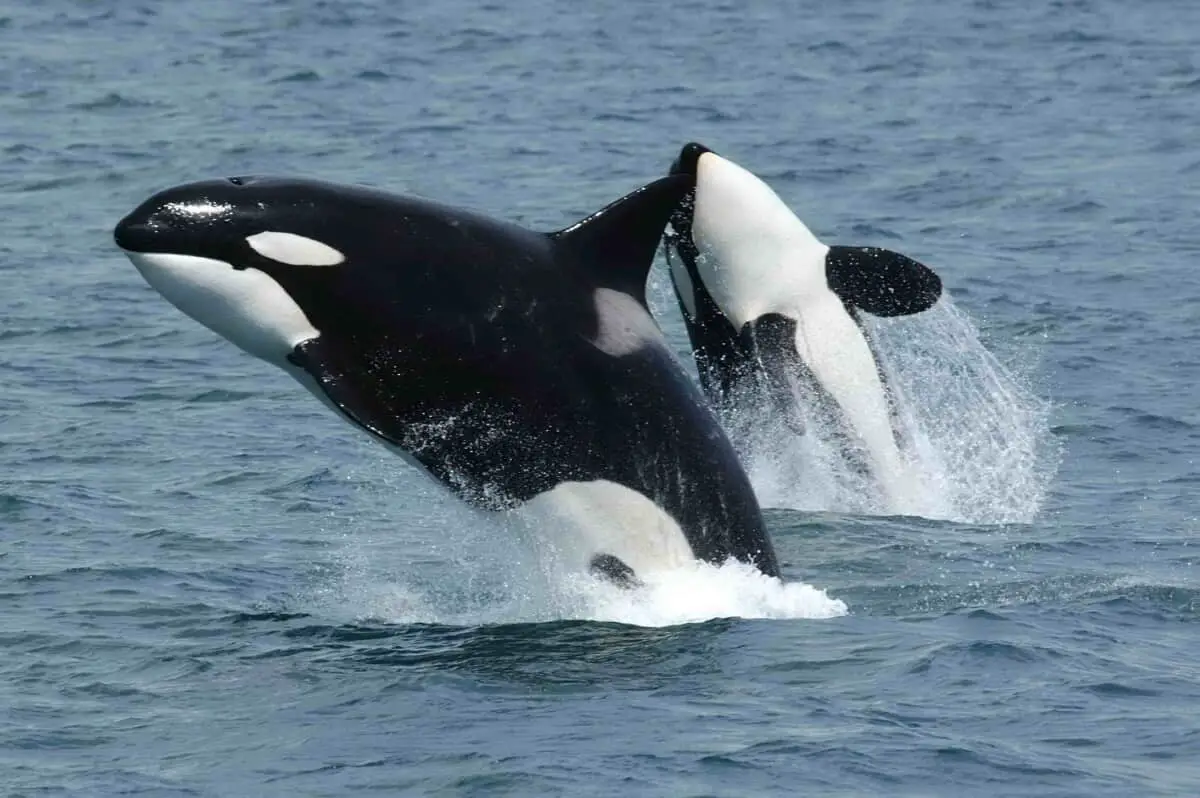As a National Park warden and diver on Vancouver Island, in the 1970’s, it was my duty to protect wildlife and soon became my passion. There was outrage when we discovered that half of the Southern Resident Orcas had been shot or captured and sold for entertainment. Most were youngsters. Now over forty years later, I am seriously concerned about the increasing number of deaths of our endangered Resident Orcas and the threat of extinction. After extensive research, I’m writing this to help document the threats to our Resident Orcas.
Southern Resident Orcas are dying primarily because of a dwindling supply of their main prey, the Chinook salmon. Additional factors include increased shipping noise interfering with their ability to catch fish, ocean waters filled with manmade toxins, and small boat traffic disturbing their feeding and resting.
What’s Really Killing Southern Resident Orcas in the Salish Sea (Listed as Endangered in Canada 2001 and in the USA 2005)
| THREAT | Effect |
| Lack of Government action to protect Orcas | No Endangered Species Legislation in British Columbia |
| Population Decline | 1995 – 98 Orcas 2020 – 72 Orcas |
| Tanker traffic – Trans Mountain Pipeline to transport bitumen would increase tanker traffic X 7 | Shipping traffic & noise interfere with Orca feeding areas; Ship strikes; No oil spill plan |
| Lack of Chinook salmon | Severe weight loss (peanut head) showing in many individuals |
| Toxins: PCB’s & fire retardants | Accumulate in Orcas; lower immune system and sperm count |
| Loved to Death by fans! | Too many boats around pods – interferes with feeding & rest (new regulations are not enforced) |
Is There a Difference between Orcas and Killer Whales?
Orcas, or precisely Orcinus orca, used to be called Black fish by fishermen in the last century. Even though Killer Whale is an accepted name, I prefer to use Orca because it is more accurate and “less loaded” with pre-conceived notions.
Fishermen in the old days didn’t realize they were dolphins and called them whales because of their tremendous size. ‘Killers’ because the pods were frightening to watch as they killed sea mammals with terrific precision and ease. In the waters off the West coast of North America, mammal-hunting Orcas called transients have evolved to hunt seals, sealions, and a variety of other mammals.

The transients are doing well on their diet and some people don’t understand why Southern Resident orcas can’t stop being so picky and just learn to eat something else? Starting 700,000 years ago, resident orcas evolved to fill a completely different niche. They gather in bigger pods to cooperatively catch oil-rich Chinook salmon, which were much larger prior to European colonization. Expecting resident Orcas to hunt seals would be like asking me, a vegetarian or more accurately a pescatarian, to hunt seals for dinner.
I refer to “our” Orcas because I believe we are all stewards of the international Salish Sea and our wild neighbors. We are the apex creatures of dry land as Orcas are the apex creatures of the sea. We’re messing up their sea, so isn’t it our job to clean it up? I agree with author Paul Heller who was describing the ocean and imagined God saying ”I entrusted you with Paradise and look what you’ve done!” How true!
Do Killer Whales Eat Humans?
NO! Orcas may look and act dangerous but so far in the wild there’s only one documented case of a surfer suffering a bite. It’s thought to have been a transient Orca and perhaps a case of mistaken identity. Surfers often claim that a surfboard with flapping arms looks like a seal or sea turtle to sharks from below.
The only incidents of people dying with Orcas are in theme parks. In these trapped circumstances, bored Orcas often chew on their cement walls, damage their teeth and become ill. This can be seen by their bent dorsal fins. It is commonly thought that their imprisonment causes mental deterioration. In several cases it isn’t known if the Orcas were playing too rough or suffering a mental break down, but the humans victims were not eaten.
Southern Resident Orcas
Apex Predator of the Oceans – FACTS
| Population | 1995 – 95; 2020 – 72 |
| Calves | 17 months gestation. |
| Life Span | Males 50 – 80 years; females 50-100 years |
| Weight | Up to 6,000 lb (2,700 kg ) |
| Brain | 15 lb (6.8 kg) – 2nd largest of ocean mammals |
| Length | Up to 26 feet (8 m) |
| Teeth | 50 teeth X 4 inches long |
| Dorsal Fin | Up to 6 feet tall (1.8 metres) in males |
| Bent Dorsal fin | Indicates Injury or poor health |
| Communication | Complex sounds heard over long distances; Echolocation accurate to 360 feet (120 m) |
| Resident Orcas’ food | Salmon, almost exclusively Chinook 150 – 375 Pounds/day |
| Swimming Distance | Up to 100 – 140 miles/day |
| Speed | Cruise 8 mph (13kph) Short Bursts 28 mph (45 kph) |
Why Worry about Orca Deaths?
My first close whale encounter was with a Gray whale. It’s fishy smelling spout misted over me just hours before I was due to give my first naturalist presentation in Pacific Rim National Park, titled “Whale Tales.” I have been inspired to study the fascinating lives of whales for many years.
I travelled to see calving Grays in Mexico, to hear the Humpbacks sing in Hawaii, and to learn about the special Orcas of Eden, Australia. These Australians orcas have been known to co-operate with human whalers by alerting and leading them to other bigger whales such as Humpbacks. To speed up the process, one orca known as Old Tom even helped pull whaling boats by rope and then helped to catch the whales in exchange for the tongue.
I chose to live beside the Salish Sea, home to Gray whales, Transient Orcas, and Resident Orcas including Granny, the famous matriarch of JPod.

As the apex predators of the Salish Sea, top of the food pyramid, Orca deaths are like the canaries dying in the coal mine. This is a WARNING of serious problems lurking in our pristine-looking tourist destinations between Seattle, Vancouver and Victoria. We welcome tourists coming from around the world in the thousands to watch our wildlife and take photographs. The Southern Residents are stars that have delighted visitors with their curiosity and playfulness; swimming up to boats to spy hop for a look and splashing their huge tail flukes.
Their value far exceeds the millions of tourist dollars that they attract.
Lives of Famous Orcas Inspire Us
Millions of people have watched and been inspired by Killer whale movies like Free Willy, Blackfish and Long Gone Wild. Many First Nation tribes in the Pacific Northwest revere the Orca as a spiritual symbol of family, which brings good fortune. Thousands of companies use Orca names and logos. These beautiful wild neighbors are like extended family to us.
Granny Orca J-2, the heroine of books and movies and matriarch of JPod, is famous for not only living for 100 years or more, but for her leadership and wisdom in finding Chinook, sharing these salmon with her pod and wowing thousands of tourists with her acrobatic leaps.
The mother Orca J-35, Tahlequah, who carried her baby over 1,000 miles for 17 days after it died, was an inspiration of maternal care. There were tears as we watched Tahlequah on the nightly news. Tahlequah’s mother was seen with peanut head, a sign of starvation, before she disappeared, now presumed dead. She had a bullet scar that researchers say indicates she survived a gun wound, probably in the 1970’s. Lately local Orcas are in the news for the number of deaths and concerns that a seven-fold increase in Oil Tanker traffic would mean extinction for this Orca family.
What We Are Losing?

Mammals the size of a bus with life spans similar to humans. Orcas have the second largest brains among all ocean mammals, weighing as much as 15 pounds. They are highly intelligent, curious, and have complex language skills. Orcas are skilled in watching fishermen and can learn how to take salmon off of long lines, changing tactics as the fishermen try to outsmart them. In New Zealand the fishermen have begun to bait and set hooks in the dark and utilize special hook covers.
Our many shared characteristics may give us a feeling of kinship. Researchers have described Orcas as “Ocean People” demonstrating intelligence, caring for family members, the active role of grandmothers in teaching the youngsters complex skills… and cultural norms.
We have cultural similarities of social skills including language, joint attention, shared goals, decision-making and empathy. Research also shows a parallel evolution of large brains, social structure and behavioural richness of marine mammals to the large brains and hyper-sociality of humans. Orca’s intelligence may have evolved to provide the ability to learn how to handle the challenges of living effectively in large pods.

During the Covid-19 pandemic, it was a joy to see photos and TV news coverage of the first Orcas to be seen swimming in Burrard Inlet in almost 60 years. Photos also showed two whales swimming in Coal Harbour where my husband and I spent our honeymoon. All this fun in the usually busy industrial Vancouver harbour!
Further information
Center for Whale Research – dedicated to the study and conservation of the Southern Resident killer whale – visit this excellent resource
Vancouver Aquarium Southern Resident website
NOAA poster of Killer Whale Ecotypes – download here.
NOAA Alaska website – Orca fact sheet
Check Out Our TOP Articles for Even More Fascinating Creatures
- How do Octopus Reproduce? (Cannibalistic Sex, Detachable Penis)
- Do Jellyfish have Brains? How Can they Hunt without Brains?
- Why are Deep Sea Fish So Weird and Ugly? Warning: Scary Pictures!
- Are Komodo Dragons Dangerous? Where Can you See Them?
- Koala Brains – Why Being Dumb Can Be Smart (Natural Selection)
- Why do Lions Have Manes? (Do Dark Manes Mean More Sex?)
- How Do Lions Communicate? (Why Do Lions Roar?)
- How Dangerous are Stonefish? Can You Die if You Step on One?
- What Do Animals Do When They Hibernate? How do they Survive?
- Leaf Cutter Ants – Surprising Facts and Adaptations; Pictures and Videos
- Irukandji Jellyfish Facts and Adaptations; Can They Kill You? Are they spreading?
- How to See MORE Wildlife in the Amazon: 10 Practical Tips
- Is it Safe to go on Safari with Africa’s Top Predators and Most Dangerous Animals?
- What to Do if You Encounter a Bullet Ant? World’s Most Painful Stinging Insect!
- How Do Anglerfish Mate? Endless Sex or Die Trying!
- How Smart are Crocodiles? Can They Cooperate, Communicate…Use Tools?
- How Can We Save Our Oceans? With Marine Sanctuaries!
- Why Are Male Birds More Colorful? Ins and Outs of Sexual Selection Made Easy!
- Why is the Cassowary the Most Dangerous Bird in the World? 10 Facts
- How Do African Elephants Create Their Own Habitat?
- What is Killing Our Resident Orcas? Endangered Killer Whales
- Why are Animals of the Galapagos Islands Unique?
- Where Can You See Wild Lemurs in Madagascar? One of the Best Places
- Where Can You see Lyrebirds in the Wild? the Blue Mountains, Australia
- Keeping Mason Bees as Pets
- Why do Flamingos have Bent Beaks and Feed Upside Down?
- Why are Hippos Dangerous? Why Do They Kill People?

